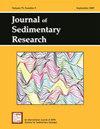Tectonostratigraphic and paleoenvironmental settings of host-replacing phreatic calcrete hardpans developed at basin margins in the Upper Devonian Kinnesswood Formation of southwest Scotland
IF 2.1
4区 地球科学
Q1 GEOLOGY
引用次数: 0
Abstract
In the Firth of Clyde area of southwest Scotland, the Famennian Kinnesswood Formation includes an interval of massive, host-replacing phreatic calcrete hardpan (HRPCH), the likes of which have been documented only at few locations and few intervals in geological history. The HRPCH is found only at basin-margin shoulders, where the Kinnesswood Formation succession is thin and incomplete. The isles of Bute and Great Cumbrae provide well exposed sections in which adjacent shoulder and trough successions can be correlated and compared to clarify the tectonostratigraphic and paleoenvironmental settings of the HRPCHs. In the Cumbraes Trough, above a thin interval of peritidal limestone, the middle part of the Kinnesswood Formation (lower part of the Foul Port Member) is pervasively disturbed by large syndepositional dewatering structures interpreted to be products of the intermittent deposition and dissolution of evaporites. These structures occur at approximately the same stratigraphic interval as the HRPCHs on the isles of Bute and possibly Arran. The HRPCH in Bute is interpreted to have developed on a syndepositional shoulder adjacent to a growth fault (the Kerrycroy Fault) delimiting a trough that accommodated intermittent seawater incursions in a restricted, evaporitic setting. This is consistent with the current model for HRPCH formation, which involves the mixing of fresh groundwater issued from source areas with the high pH groundwater that surrounds evaporitic basins. A significant increase in silica solubility paired with a decrease in calcite solubility occurs in the mixing zone, thus promoting the thorough replacement of silicates with calcrete.苏格兰西南部上泥盆统Kinnesswood组盆地边缘沉积的充填型潜水钙质硬岩的构造地层及古环境背景
在苏格兰西南部的克莱德湾地区,Famennian Kinnesswood组包括一段巨大的、主岩替代的潜水钙混凝土硬层(HRPCH),在地质史上,此类地层仅在少数位置和少数间隔有记录。HRPCH仅在盆地边缘肩部发现,其中Kinnesswood组序列较薄且不完整。布特岛和大坎布雷岛提供了暴露良好的剖面,在这些剖面中,可以对相邻的肩部和槽序列进行关联和比较,以阐明HRPCH的构造地层图和古环境背景。在Cumbraes海槽中,在一层薄的潮缘石灰岩之上,Kinnesswood组的中部(Foul Port段的下部)普遍受到大型同沉积脱水结构的干扰,这些脱水结构被认为是蒸发岩间歇性沉积和溶解的产物。这些结构与布特岛(可能还有阿伦岛)上的HRPCH的地层间隔大致相同。布特的HRPCH被解释为在生长断层(Kerrycroy断层)附近的同沉积台肩上发育,该断层界定了一个槽,该槽在受限制的蒸发环境中容纳间歇性海水入侵。这与HRPCH地层的当前模型一致,该模型涉及从源区排出的新鲜地下水与蒸发盆地周围的高pH地下水的混合。在混合区中,二氧化硅溶解度显著增加,方解石溶解度降低,从而促进了硅酸盐被钙矾土彻底取代。
本文章由计算机程序翻译,如有差异,请以英文原文为准。
求助全文
约1分钟内获得全文
求助全文
来源期刊
CiteScore
3.80
自引率
5.00%
发文量
50
审稿时长
3 months
期刊介绍:
The journal is broad and international in scope and welcomes contributions that further the fundamental understanding of sedimentary processes, the origin of sedimentary deposits, the workings of sedimentary systems, and the records of earth history contained within sedimentary rocks.

 求助内容:
求助内容: 应助结果提醒方式:
应助结果提醒方式:


